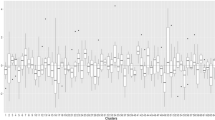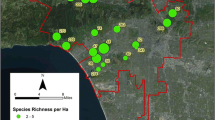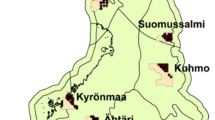Abstract
The aim of this work was to examine how well species-specific stand attributes can be predicted using a combination of airborne laser scanning (ALS) and existing stand register data in urban forests. In this context, the ability of three data combinations: ALS data and stand register data, ALS data and digital aerial images and all of these combined, was tested in the prediction of species-specific basal areas. We divided tree species into seven and three different tree species strata and applied two prediction methods: (1) regression method, in which the predicted total basal area was divided into tree species based on tree species proportions from stand register data, and (2) the nearest neighbour (NN) method, in which tree species proportions were used as predictor variables for species-specific basal areas. Prediction models were built based on training data of 205 field plots, and the accuracy of the models was tested based on validation data of 52 forests stands. Our results showed that species-specific predictions of seven tree species were more accurate when tree species proportions from stand register data were used in the prediction. Both the regression and the NN method provided reasonable accuracy. This study showed that tree species information from existing stand register data could be used as an alternative for aerial images in ALS-based forests inventories. The use of ALS data together with stand register data and small field data could also be economically beneficial in an inventory of urban forests.







Similar content being viewed by others
References
Axelsson P (2000) DEM generation from laser scanning data using adaptive TIN models. Int Arc Photogramm Remote Sens 33:110–117
Baskerville GL (1972) Use of logarithmic regression in the estimation of plant biomass. Can J Forest Res 2:49–53
Breidenbach J, Nothdurft A, Kändler G (2010a) Comparison of nearest neighbour approaches for small area estimation of tree species-specific forest inventory attributes in central Europe using laser scanning. Eur J Forest Res 129:833–846
Breidenbach J, Næsset E, Lien V, Gobakken T, Solberg S (2010b) Prediction of species-specific forest inventory attributes using a nonparametric semi-individual tree crown approach based on fused airborne laser scanning and multispectral data. Remote Sens Environ 114:911–924
Cajander AK (1949) Forest types and their significance. Acta Forestalia Fennica 56
Finnish Statistical Yearbook of Forestry 2011 (2011) Finnish forest research institute. Vantaa, Finland, pp 68–84
Fowler RJ, Little JJ (1979) Automatic extraction of irregular network digital terrain models. Comput Graph 13:199–207
Franklin SE, Hall RJ, Moskal LM, Maudie AJ, Lavigne MB (2000) Incorporating texture into classification of forest species composition from airborne multispectral images. Int J Remote Sens 21(1):61–79
Haralick RM, Shanmugam K, Dinstein J (1973) Textural features for image classification. IEEE Trans Syst Man Cybern 3:610–621
Holmgren J (2004) Prediction of tree height, basal area and stem volume using airborne laser scanning. Scand J For Res 19:543–553
Koivuniemi J, Korhonen KT (2006) Inventory by compartments. In: Kangas A, Maltamo M (eds) Forest inventory: methodology and applications. Springer, pp 271–278
Landis RJ, Koch GG (1977) The measurement of observer agreement for categorical data. Biometrics 33:159–174
Maltamo M, Korhonen KT, Packalén P, Mehtätalo L, Suvanto A (2007) Testing the usability of truncated angle count sample plots as ground truth in airborne laser scanning based forest inventories. Forestry 80:73–81
Maltamo M, Packalén P, Kallio E, Kangas J, Uuttera J, Heikkilä J (2011) Airborne laser scanning based stand level management inventory in Finland. Proceedings of Silvilaser 2011–11th international conference on lidar applications for assessing forest ecosystems. University of Tasmania, Australia, October 16–20
Miller RW (1997) Urban forestry: planning and managing urban green spaces, 2nd ed. Prentice-Hall, New Jersey
Moeur M, Stage AR (1995) Most similar neighbor: an improved sampling inference procedure for natural resource planning. Forest Sci 41:337–359
Næsset E (2002) Predicting forest stand characteristics with airborne scanning laser using a practical two-stage procedure and field data. Remote Sens Environ 80:88–99
Næsset E (2004) Practical large-scale forest stand inventory using small-footprint airborne scanning laser. Scand J For Res 19:64–179
Packalén P, Maltamo M (2006) Predicting the plot volume by tree species using airborne laser scanning and aerial photographs. Forest Sci 52:611–622
Packalén P, Maltamo M (2007) The k-MSN method for the prediction of species-specific stand attributes using airborne laser scanning and aerial photographs. Remote Sens Environ 109:328–341
Packalén P, Maltamo M (2008) Estimation species specific diameter distribution using airborne laser scanning and aerial photographs. Can J For Res 38:1750–1760
Packalén P, Temesgen H, Maltamo M (2012) Variable selection strategies for nearest neighbour imputation methods used in remote sensing-based forest inventory. Can J Remote Sens 38(5):1–13
Robinette C (1972) Plants, people and environmental quality. Department of the Interior. National Park Service, Washington
Shrestha R, Wynne RH (2012) Estimating biophysical parameters of individual trees in an urban environment using small footprint discrete-return imaging lidar. Remote Sens 4(2):484–508
Tuominen S, Pekkarinen A (2005) Performance of different spectral and textural aerial photograph features in multi-source forest inventory. Remote Sens Environ 94:256–268
Vauhkonen J, Korpela I, Pitkänen J, Olofsson K (2010) Estimating plot-level forest attributes per species by single-tree imputing using airborne laser scanning-based height, intensity, and alpha shape metrics. In: Vauhkonen J (ed) Estimating single-tree attributes by airborne laser scanning: methods based on computational geometry of 3-D point data. Academic Dissertations. Dissertationes Forestales 104:1–28
Venables WN, Ripley BD (2002) Modern applied statistics with S, 4th edn. Springer, New York
Voss M, Sugumaran R (2008) Seasonal effect on tree species classification in an urban environment using hyperspectral data, LiDAR, and an object-oriented approach. Sensors 8:3020–3036
Zhang C, Qiu F (2011) Mapping individual tree species in an urban forest using airborne lidar data and hyperspectral imagery. Photogramm Eng Remote Sens 78(10):1079–1087
Acknowledgments
This work was funded by Turku city (The Project ‘Cost-effective inventory of urban forests using airborne laser scanning—Case study of Turku’) and the strategic funding of University of Eastern Finland, which are acknowledged. Furthermore, Prof. Heli Peltola is thanked for revising the structure and language of this paper.
Author information
Authors and Affiliations
Corresponding author
Additional information
Communicated by Gerald Kaendler
Appendices
Appendix 1
See Table 3.
Appendix 2
See Table 4.
Rights and permissions
About this article
Cite this article
Pippuri, I., Maltamo, M., Packalen, P. et al. Predicting species-specific basal areas in urban forests using airborne laser scanning and existing stand register data. Eur J Forest Res 132, 999–1012 (2013). https://doi.org/10.1007/s10342-013-0736-8
Received:
Revised:
Accepted:
Published:
Issue Date:
DOI: https://doi.org/10.1007/s10342-013-0736-8




